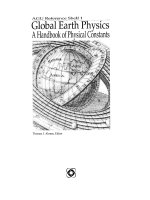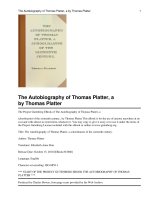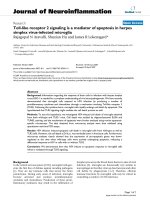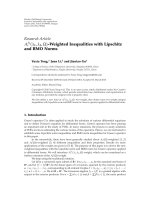3 1 2 thomas jefferson a man of ideas
Bạn đang xem bản rút gọn của tài liệu. Xem và tải ngay bản đầy đủ của tài liệu tại đây (3.03 MB, 10 trang )
Fascinating Facts
• Thomas Jefferson was a fine violinist. He played
the violin when he took breaks while writing
the Declaration of Independence.
• The name Monticello means “little mountain”
in Italian.
• Jefferson did not seat people at his dinner table
according to their ranks. He considered every
person at his table equal.
Genre
Nonfiction
Comprehension Skill
Summarize
Text Features
•
•
•
•
Captions
Glossary
Map
Headings
Thomas Jefferson
Scott Foresman Social Studies
ISBN 0-328-14838-5
ì<(sk$m)=beidih< +^-Ä-U-Ä-U
A MAN OF IDEAS
by Pat McCarthy
In this book you will read about Thomas
Jefferson. He wrote many important
documents for our government. He was
the third President of the United States
and did many other jobs for our country.
Vocabulary
Write to It!
Jefferson wrote about people’s rights. Is
there a right you think people should
have? Write a paragraph about your ideas.
council
direct democracy
governor
Write your paragraph on a separate sheet
of paper.
responsibility
candidate
Photographs
Thomas Jefferson
A MAN OF IDEAS
Every effort has been made to secure permission and provide appropriate credit for photographic material. The publisher deeply
regrets any omission and pledges to correct errors called to its attention in subsequent editions.
Unless otherwise acknowledged, all photographs are the property of Scott Foresman, a division of Pearson Education.
by Pat McCarthy
Photo locators denoted as follows: Top (T), Center (C), Bottom (B), Left (L), Right (R) Background (Bkgd)
ISBN: 0-328-14838-5
Copyright © Pearson Education, Inc. All Rights Reserved. Printed in the
United States of America. This publication or parts thereof, may be used with appropriate
equipment to reproduce copies for classroom use only.
1 2 3 4 5 6 7 8 9 10 V0G1 14 13 12 11 10 09 08 07 06 05
Opener: (C) Stock Montage/SuperStock, (Bkgd) ©Joseph Sohm; Visions of America/Corbis
2 (B1) Fred J. Maroon/Photo Researchers, Inc., (B2) Getty Images
3 Lee Snider/Photo Images/Corbis
4 Bettmann/Corbis
5 John Neubauer/PhotoEdit
Editorial Offices: Glenview, Illinois • Parsippany, New Jersey • New York, New York
6 ©Joseph Sohm; Visions of America/Corbis
7 Bettmann/Corbis
Sales Offices: Needham, Massachusetts • Duluth, Georgia • Glenview, Illinois
8 C.W. Jarvis/Corbis
Coppell, Texas • Ontario, California • Mesa, Arizona
9 (B1) Christie’s Images/Bridgeman Art library, (B2) Getty Images
10 Getty Images
11 Stock Montage Inc.
12 William Manning/Corbis
13 Monticello/Thomas Jefferson Foundation, Inc.
14 The New York Public Library/Art Resource, NY
A Man of Ideas
Thomas Jefferson was a man of many ideas.
He stated these ideas clearly in his writing.
Much of our government is based on Jefferson’s
ideas. He wrote some of our country’s most
important documents.
Jefferson was born April 13, 1743, on a farm
in Virginia. He had seven brothers and sisters.
When Jefferson was born, Virginia belonged to
England. It was one of thirteen British colonies
in the New World.
Thomas Jefferson
William and Mary College
Jefferson’s Education
Jefferson attended a one-room school where
he learned to read, write, and do arithmetic.
His father later sent him to a teacher to learn
French, Latin, and Greek.
From his father, Jefferson learned to exercise.
He also learned to be independent. “Never
ask another to do for you what you can do for
yourself,” his father said.
When Jefferson was fourteen, his father died.
Jefferson attended another school for two years.
When he was sixteen, Jefferson went to the
College of William and Mary in Virginia. A
professor, Dr. William Small, liked Jefferson and
introduced him to important people in Virginia.
2
3
After two years Jefferson left college to study
law with a famous lawyer, George Wythe. They
discussed legal cases. Jefferson read law books
and went to court. He wrote that Wythe was
“my faithful and beloved mentor [teacher] in
youth and my most affectionate [loving] friend
through life.”
Jefferson Enters Politics
Jefferson became a lawyer in 1767. In 1769 he
was elected to the House of Burgesses, which made
laws for Virginia. Like many other Virginians,
Jefferson was unhappy with British rule.
Jefferson studied law.
Jefferson’s home, Monticello
Jefferson Settles Down
Jefferson married Martha Skelton in 1772.
He built a house on land his father had left
him. He named the house Monticello.
During this time, the American colonies
were becoming more and more unhappy with
British rule. They did not think England should
control them.
In 1774 Jefferson became known in the
colonies when he wrote a booklet about the
colonists’ rights. He said that England did not
have the right to make laws for the colonies.
This booklet was called A Summary View of the
Rights of British America.
4
5
The Colonies Fight the Revolution
Preamble to the Declaration of Independence
The colonies were now fighting a war to win
their freedom from England. This was called the
Revolutionary War and it lasted for eight years.
In 1777 Jefferson wrote another important
document. It was called the Virginia Statute for
Religious Freedom. It said the government should
not tell people what to believe or what religion
to follow.
The Colonies Declare Independence
In 1774 a council of representatives from the
colonies met in Philadelphia. This was the First
Continental Congress.
The next year, the Second Continental Congress
declared themselves free from England. Jefferson
wrote the paper that said this to the English rulers.
This was the Declaration of Independence.
It took two weeks for Jefferson to write the
Declaration of Independence. Jefferson said
it was meant to be “an expression of the
American mind.” It explained that when men
tried to settle problems with their rulers and
could not, they had the right to break ties with
their rulers. The colonies wanted to be a direct
democracy.
Congress passed the Declaration of
Independence. It was signed on July 4, 1776.
6
Signing of the Declaration of Independence
7
In 1779, during the war, Jefferson was elected
governor of Virginia. This was a terrible time
for him. Jefferson was in charge of saving
Virginia from the British, but the colony had no
money to buy food or supplies for the soldiers.
The British attacked Virginia. People blamed
Jefferson for Virginia’s problems.
Back to Monticello
Jefferson’s term as governor ended before
the war did. Jefferson went back to Monticello
and wrote a book about Virginia. The war ended
in 1783.
Jefferson wrote a book about Virginia.
In 1782, Martha Jefferson died after the birth
of the Jeffersons’ sixth child. Jefferson was so
sad that he stayed in his room for three weeks.
His daughter, Martha, was the only one allowed
into the room with him.
Jefferson Serves His Country
Jefferson’s country needed him, though, and
he felt some responsibility. He was elected to
the new Congress and wrote several important
papers.
Soon Jefferson was asked
to help John Adams and
Benjamin Franklin
make treaties, or
agreements, with
nations in Europe.
Jefferson agreed
to go to France.
He stayed in
France for five years.
John Adams
8
9
While Jefferson was gone, George Washington
was elected the first President of the United
States. Washington asked Jefferson to be
Secretary of State. Jefferson served for three
years and helped the United States get along
with other countries.
In 1796 Jefferson ran as a candidate for
President but lost to his friend John Adams.
Jefferson became Vice President. The two men
had very different ideas and did not get along
anymore.
Jefferson as President
In 1801 Jefferson beat
Adams in an election and
became President. He got
up at five o’clock in the
morning and spent
hours each day at his
desk. He held dinners
and served new foods,
such as ice cream
and macaroni.
Thomas Jefferson
10
Lewis and Clark explored the new land.
In 1803 Jefferson arranged for the United
States to buy Louisiana from France. It stretched
from the Rocky Mountains to the Mississippi
River. This new territory doubled the size of the
United States.
Jefferson sent Meriwether Lewis and William
Clark to explore the new land. He told them to
find out about the soil, plants, animals, and the
land. Lewis and Clark traveled eight thousand
miles in a little more than two years. They
brought back drawings, maps, and journals.
When some people heard about Lewis and
Clark’s findings, they moved west. This was
the beginning of the westward movement
in America.
11
Jefferson’s Retirement
Jefferson decided not to run for a third term as
President. He was happy to return to Monticello.
He wrote to a friend, “Never did a prisoner
released from his chains feel such relief.”
Jefferson enjoyed his grandchildren and his
many visitors, but he liked to spend time by
himself reading. He often said, “I cannot live
without books.”
The British burned the library in Washington,
D.C., during the War of 1812. Jefferson offered
his own library to replace it, and Congress
bought his books. This was the beginning of
what is now the Library of Congress.
Library of Congress
Jefferson invented the revolving bookstand.
Jefferson spent a lot of time writing letters. He
and John Adams became friends again and wrote
letters to each other for the rest of their lives.
Jefferson was an inventor too. He invented
a revolving stand that held five books and
a portable desk that he used to write the
Declaration of Independence. He also invented
a macaroni machine and a plow with an
iron blade.
12
13
Jefferson was buried under a big oak tree on
a hillside at Monticello. His wife Martha, his
daughter Maria, and his sister Jane were buried
nearby. He designed his own tombstone, which
tells the things he did that he was most proud
of. It said:
HERE WAS BURIED
THOMAS JEFFERSON
AUTHOR OF THE
University of Virginia
DECLARATION
OF
After he retired, Jefferson’s biggest project was
establishing the University of Virginia. It was
the first university that was not connected to
a church. The university opened in March of
1825. Jefferson invited all the students to dinner
at Monticello.
Jefferson’s Death
Thomas Jefferson died at Monticello on
July 4, 1826. It was fifty years after the
Declaration of Independence was signed.
Jefferson was eighty-three years old. John
Adams died the same day in Massachusetts.
14
AMERICAN INDEPENDENCE
OF THE
STATUTE OF VIRGINIA
FOR
RELIGIOUS FREEDOM
AND FATHER OF THE
UNIVERSITY OF VIRGINIA
15
In this book you will read about Thomas
Glossary
Jefferson. aHe
wrote who
many
important
candidate
person
runs
for office
documents for our government. He was
council
a group
of people
make
laws
the third
President
of the who
United
States
and
for a other
community
and rules
did many
jobs for our country.
direct democracy government run by the
people who live under it
Vocabulary
governor a person elected as the head of a
council
state in the United States
direct democracy
responsibility a duty; something that must
governor
be done
responsibility
Write to It!
Jefferson wrote about people’s rights. Is
there a right you think people should
have? Write a paragraph about your ideas.
Write your paragraph on a separate sheet
of paper.
candidate
Photographs
Every effort has been made to secure permission and provide appropriate credit for photographic material. The publisher deeply
regrets any omission and pledges to correct errors called to its attention in subsequent editions.
Unless otherwise acknowledged, all photographs are the property of Scott Foresman, a division of Pearson Education.
Photo locators denoted as follows: Top (T), Center (C), Bottom (B), Left (L), Right (R) Background (Bkgd)
ISBN: 0-328-14838-5
Copyright © Pearson Education, Inc. All Rights Reserved. Printed in the
United States of America. This publication or parts thereof, may be used with appropriate
equipment to reproduce copies for classroom use only.
16
1 2 3 4 5 6 7 8 9 10 V0G1 14 13 12 11 10 09 08 07 06 05
Opener: (C) Stock Montage/SuperStock, (Bkgd) ©Joseph Sohm; Visions of America/Corbis
2 (B1) Fred J. Maroon/Photo Researchers, Inc., (B2) Getty Images
3 Lee Snider/Photo Images/Corbis
4 Bettmann/Corbis
5 John Neubauer/PhotoEdit
6 ©Joseph Sohm; Visions of America/Corbis
7 Bettmann/Corbis
8 C.W. Jarvis/Corbis
9 (B1) Christie’s Images/Bridgeman Art library, (B2) Getty Images
10 Getty Images
11 Stock Montage Inc.
12 William Manning/Corbis
13 Monticello/Thomas Jefferson Foundation, Inc.
14 The New York Public Library/Art Resource, NY









